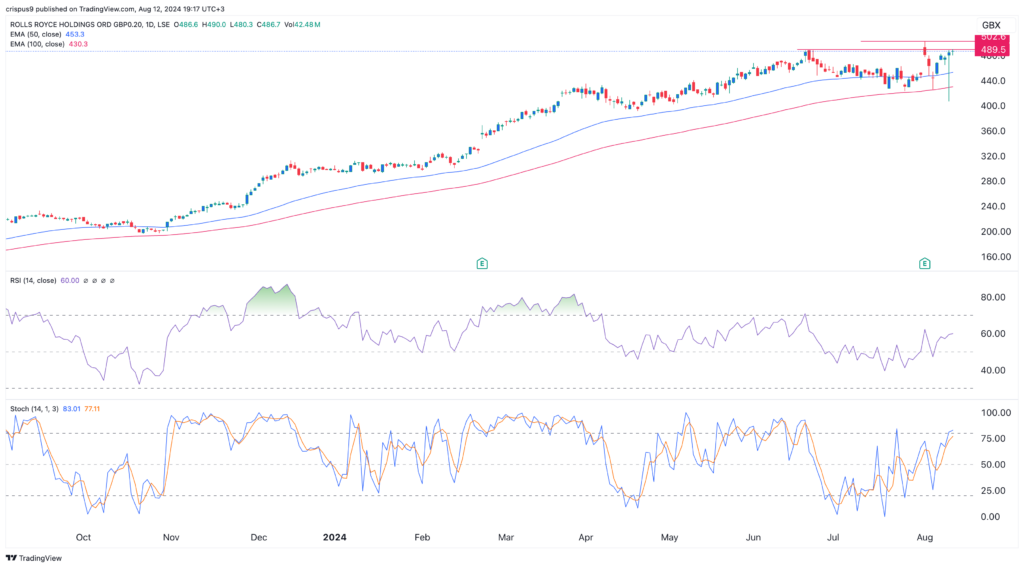Rolls-Royce (LON: RR) share price has held steady this year, making it one of the best-performing companies in the FTSE 100 index. It has risen by over 64% this year, giving it a market cap of over £41 billion.
Rolls-Royce is doing well
Rolls Royce, one of the leading industrial companies in the world, is doing well, helped by the rising demand across its three key divisions and great execution.
It confirmed this view recently when it published its financial results for the first half of the year. The numbers showed that its underlying revenue rose to £8.18 billion this year, higher than the £6.95 billion it made a year earlier.
Its operating profit nearly doubled as it moved from £673 million to over £1.14 billion while its profit before taxation soared to over £1.03 billion. Most importantly, Rolls-Royce generated a free cash flow of over £1.15 billion.
These results demonstrated that the management was executing well at a time when supply chain constraints are continuing. Most of its improvement came from its civil aviation business, where the company sells engines and then takes Long Term Service Agreements (LTSA).
When everything is going on well, the LTSA strategy is highly profitable since its airline customers pay for every flight hour, a process that spreads costs, making it more affordable to them. It is Rolls-Royce’s biggest cash earner.
Rolls-Royce is also growing its margins across all its divisions. Its civil aviation’s operating margins rose to 18% while the defense and power systems rose to 15.5% and 10.3%, respectively. If this trend continues, it means that the company is set to hit its mid-term targets ahead of schedule.
Meanwhile, Roll-Royce Holdings is also benefiting from the data center business as the artificial intelligence craze continues. Its power business had over $1.8 billion in revenues and an operating profit of over £189 million.
Most importantly, Rolls-Royce has improved its balance sheet. It ended the last quarter with over £6.8 billion in available liquidity, with its cash and equivalents standing at £4.3 billion. It has also reduced its net debt to over £0.8 billion, down from the pandemic high of £5.2 billion.
Additionally, Rolls-Royce investors will now benefit from the stock appreciation and a dividend, which will be between 30% and 40% of its underlying profit.
Rolls-Royce valuation and catalysts
The main concern among investors is whether Rolls-Royce is overvalued or undervalued. Recent data shows that the company has a market cap of over £41 billion or $52 billion, making it the 16th biggest company in the UK.
This valuation makes it significantly smaller than General Electric Aerospace, the biggest jet engine manufacturer in the world, which has a valuation of over $179 billion. GE Aerospace made over $9.1 billion in revenues in the last quarter.
In terms of multiples, data shows that Rolls-Royce Holdings trades at a price-to-earnings ratio of 17, which is lower than the S&P 500 average of 21 and the FTSE 100 index average of 19. This means that the company is still at a discount since its revenue growth rate is better than that of the S&P 500 and FTSE 100.
Rolls-Royce is also trading at a discount than most of its industrial rivals. GE Aviation has a price-to-earnings multiple of 45 while companies like Howmet Aerospace (HWM), Safran, and RTX have multiples of over 40. These multiples mean that the company is trading at a discount.
Other metrics show that the company is undervalued. A discounted free cash flow (DCF) valuation shows that the company is relatively cheap. According to Simply Wall St, the company was trading at a 54% discount to its fair value.
Therefore, fundamentally, the company seems like it is undervalued. Besides, it is growing, its business is seeing strong demand, and is now a leaner company than what it was during the Covid-19 pandemic. It has also received upgrades from the three leading rating agencies like Moody’s, Fitch, and S&P Global.
However, the management will need to execute well to justify the current valuation. This means that they need to ensure the quality of its engines to prevent the maintenance woes it had a few years ago.
Rolls-Royce share price forecast

The daily chart shows that the RR stock price has been in a strong bull run this year and recently soared to a record high of 502p. It has remained above the 50-day and 100-day Exponential Moving Averages (EMA).
The Relative Strength Index (RSI) and the Stochastic Oscillator have continued rising, meaning that it has strong momentum. The stock has formed what looks like a double-top pattern.
Therefore, the stock needs to move above that resistance at 502p to confirm the bullish trend. If this happens, the next point to watch will be at 600p.
The post Rolls-Royce share price analysis: buy, sell or hold? appeared first on Invezz

